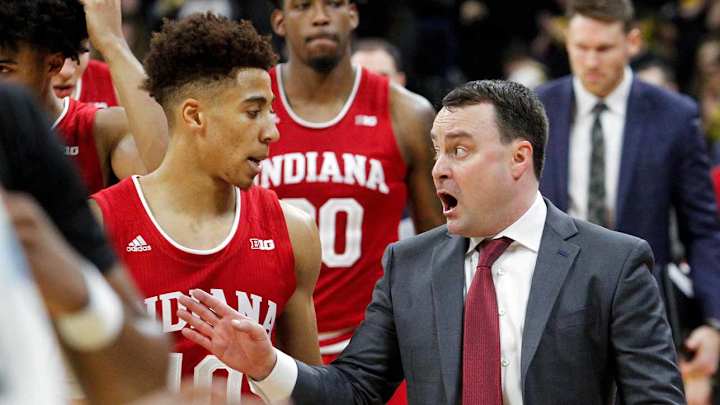Indiana Is 2019's Most Polarizing Bubble Team

It isn’t often that a team entering the final week of the regular season at 15–14 overall and 6–12 in its own conference, a team that just put a 1–12 stretch in its rearview mirror, is firmly on the radar for an at-large NCAA tournament bid. Then again, it’s rare that a team capable of losing in such abundance could also win five games against teams as good as Michigan State, Wisconsin, Marquette and Louisville have been this season. Put all of that on one résumé, and you get the 2018–19 Indiana Hoosiers, far and away this season’s most interesting bubble case.
The mere fact that Indiana is on the bubble is going to make a lot of people angry. After all, should we really be rewarding a team with 14 losses (and counting) with an at-large bid? If a team can wash away that many losses with a handful of strong victories, isn’t the value of the regular season lessened? What chance do smaller schools that will never get to play the sort of schedule that Indiana has this year have of earning at-large bids? These are all fair questions, but their existence doesn’t mean Indiana shouldn’t be rewarded for the work it has done.
Indiana represents one side of the inherent push-and-pull of the bubble and the dichotomy between high- and mid-majors. For sake of comparison, let’s consider Utah State. The Aggies are 24–6 overall after an emotional win over Nevada last weekend. They’re 14–3 in the Mountain West and will likely move to 15–3 against Colorado State on Tuesday. They’re 2–2 in Quadran 1 games, 2–3 in Quadrant 2 games, and ranked 30th in NET. In short, they’ve won a lot of games and made the most of their limited opportunities.
The Hoosiers can’t quite measure up to Utah State in many respects. Forget merely about the wins and losses. Indiana is ranked 55th in NET and trails Utah State on kenpom.com and in T-Rank, two analytically driven websites that help us make apples-to-apples comparisons among 353 teams that are never going to have equality of opportunity. If these metrics matter (and they do), then Indiana has little hope of catching a team like Utah State. The only way it can is by piling up big-time victories, and it has done that. Indiana has six Q1 wins, tied for 14th-most in the country. A non-comprehensive list of teams with fewer than six Q1 wins: Gonzaga, Texas Tech, Virginia Tech, Iowa State, Florida State, Louisville and Villanova. Just like Utah State needs to get the credit it deserves for doing the best it could with its scheduling disadvantage, Indiana too, needs to be recognized for beating high-level, at-large-quality competition at a rate with some of the best teams in the country.
The Indiana problem shows why there’s rarely a wrong answer on the bubble (2016 Tulsa aside). Should the committee reward the mid-majors who dominate their competition but will never get more than a few chances to prove themselves against high-profile programs, or should it favor high-majors that have lost a lot of games in brutal conferences, but have also won more than their fair share against the best of the best? The answer to both questions can be yes, but that doesn’t change the fact that at-large bids are a zero-sum game. On Selection Sunday, no matter what the committee values, the bracket remains a 68-piece puzzle.
Like it or not, Indiana is comfortably in the mix to be one of those pieces. So, what do the Hoosiers need to do to get into the field? Let’s first go to our friends at T-Rank, which produce a helpful metric called similarity scores, which looks at a team’s present résumé and finds the résumés most similar to it from previous seasons. Click here for Indiana’s similarity scores, and you’ll see that of the 10 most similar to it dating back to 2009, just two—2018 Arizona State and 2016 Syracuse—made the tournament. Arizona State lost in the first round, while Syracuse made the Final Four. If that’s not a perfect distillation of what it means to be a bubble team, I don’t know what is.
So what’s Indiana’s path into the field of 68? First, the Hoosiers absolutely need to avoid any losses to teams off the at-large radar. That means they must take care of business against Illinois and Rutgers this week. Indiana’s seed in the Big Ten tournament still isn’t locked in, but if it does win those two games, it will be no worse than 10th. The Hoosiers’ first game in the Big Ten tournament will come against either a team completely lacking at-large hopes or another one of the Big Ten’s bubble occupants, Minnesota or Ohio State. That has to be a win. From there, they’d play one of the conference’s tournament locks, most likely Purdue, Michigan or Michigan State. That game would likely be a de facto play-in game for the Hoosiers.
Win, and they’ll be in line for an at-large bid. Lose, and they’re likely headed to the NIT. Even this late in the year, 14-loss teams can dream.

Michael Beller is SI.com's fantasy sports editor and a staff writer covering fantasy, college basketball and MLB. He resides in Chicago and has been with SI.com since 2010.